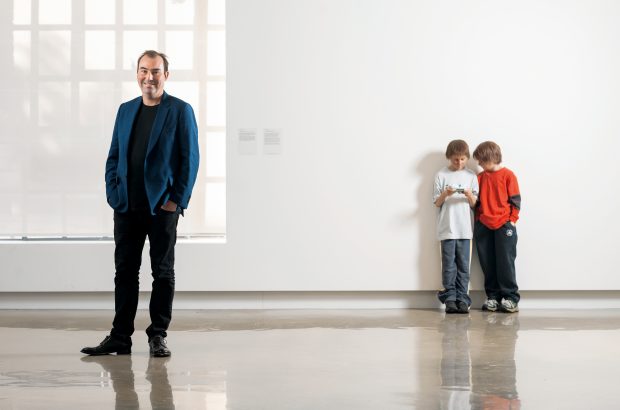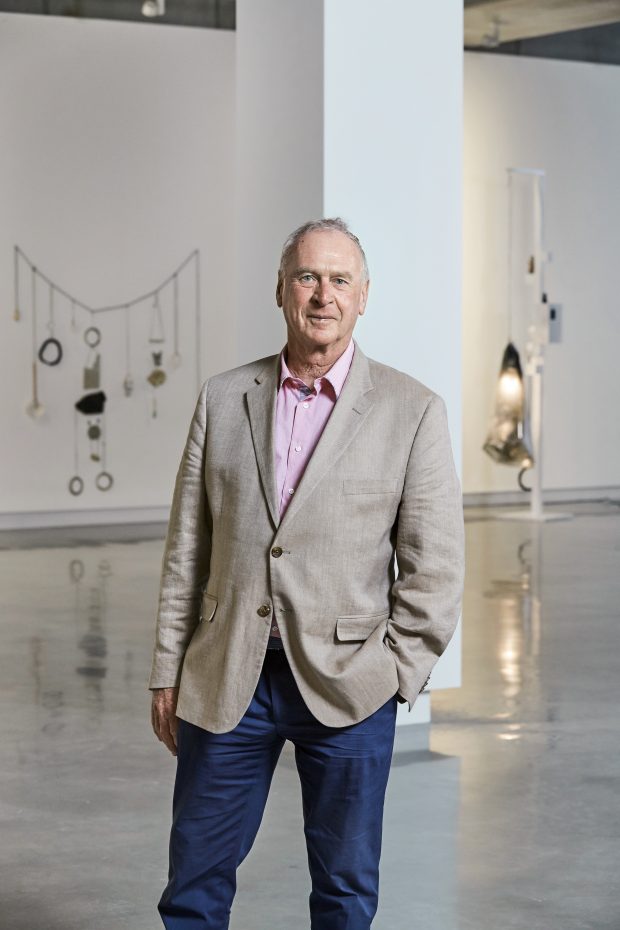Buxton Contemporary
A collector’s multi-million dollar vision and treasure trove of art adds a new dimension to Southbank. By Andrew Stephens (B Fine Arts 1994, PGDipArts (ArtHist&CinSt) 2001).

Ryan Johnston, with
Patricia Piccinini’s Game
Boys Advanced (2002);
Silicon, acrylic human
hair and mixed media.
PICTURE: EAMON GALLAGHER
When the new Buxton Contemporary museum opened in March, it marked the fruition of a project that Michael Buxton had mulled through decades of being an avid gallery-goer. Since the early 1990s, his goal had been to establish a suitable home for his art collection, quietly accumulated with the help of expert curators and his own ‘inbuilt radar’. Mr Buxton, the property developer who co-founded the MAB Corporation with his brother Andrew in the mid-1990s, has devoted much of his spare time to visiting galleries and artists’ studios. In those places, his ‘radar’ activates: he sees art, he responds to it, and he generally knows when he’s looking at something with depth and quality. More than that, he can see the sort of work that will endure beyond fashion – an attribute evident in the museum’s inaugural exhibition The shape of things to come.
“To sit Emily Floyd’s Temple of the female eunuch (2008), a work over 10 years old, alongside Francis Upritchard’s Echo Cabinet – one of the most recent acquisitions – highlights how the collection evolves, making connections between works and practices,” he says. “These two works are also epic pieces, in both scale and foresight; I have no doubt they will resonate long into the future of Australian contemporary practice.”
Little wonder that seeing the museum’s doors finally open after exhaustive planning has brought this avid collector a great sense of joy. “It is a 25-year dream finally come to fruition,” he says in a satisfied tone. “And the final result is better than I ever dreamed it could be.”
Mr Buxton’s modus operandi over the journey has been part-instinct, part-education, thanks to that small band of curators who have counselled him and helped with his plan to house the Michael Buxton Collection in a purpose-built art museum. That it has ended up being at the University of Melbourne’s Southbank campus is something that clearly pleases him.
In 2014, Mr Buxton signed the deed donating the bulk of his collection to the University, along with a 20-year endowment and $8 million for the $12 million museum located behind an existing building at the corner of Dodds St and Southbank Boulevard. Designed by Fender Katsalidis, it has two extensive gallery levels and zones intended for education.

The new
museum houses
artworks
collected by
Mr Buxton over
decades.
PICTURES:
EAMON GALLAGHER;
BUXTON
CONTEMPORARY
The donation involves 341 artworks by 53 artists, most from the designated Michael Buxton Collection, plus a few from the private Buxton family collection (a separate endeavour Michael and Janet Buxton, his wife, have long pursued). The new Buxton Contemporary Committee is composed 60 per cent University of Melbourne representatives and 40 per cent representatives of the Buxton family. It is co‑chaired by VCA Professor in Art Su Baker and Mr Buxton.
Since launching his eponymous collection, Mr Buxton’s ambition for a new museum has been deeply enmeshed with his goal of making the collection publicly accessible – moreover, to integrate it into University programs.
“What is important to me is that we see the museum as a place where we can educate. The fact it has gone to the University is even more significant from that point of view.”
Little surprise then that education is a top priority for Buxton Contemporary’s inaugural director, Ryan Johnston, who studied at the University – a Graduate Diploma (Art History) in 2002 and a Postgraduate Diploma (Art History) in 2003 – and returned as a lecturer at the former School of Creative Arts (2007‑2009). He also tutored in Art History and breadth subjects 2004-2008. He says the museum’s dedicated education space will allow staff to easily curate artwork for display so students can have object-based learning. “When I was learning, you spent a lot of time looking at slides only,” he says. “This is an amazing opportunity to look at objects.”
Not only will VCA visual arts students be involved, but also students from diverse disciplines across campuses. “It is broader, in a sense, than in a regular art gallery, which tends to take a curatorial or art historical perspective on things – whereas, at a university, you have people from across the entire range of academic disciplines, and you can marshal that as a really rich cultural experience.”
Mr Johnston, formerly Head of Art at Canberra’s Australian War Memorial (2012-2018), admires the Buxton approach to acquiring art. He describes Mr Buxton’s collecting as a unique and genuine passion, “well beyond a collector’s usual aspirations”.
Having initially consulted art aficionados Anna Schwartz and John Buckley, Mr Buxton later drew on the expertise of curators Charlotte Day, Max Delany, Mark Feary, Samantha Comte and Luisa Bosci. Visiting galleries and exhibitions frequently, he bounced his own ideas off these curators. They, in turn, offered guidance which, along with the MBC board, brought a discipline to the process, governed by certain rules about who and what could be collected. All of it was aimed at ensuring the highquality collection would represent significant living Australian (and some New Zealand) artists in depth and across time.
Standing in the new museum, Mr Johnston is impressed with the way the design comfortably allows for an array of two-dimensional work, installations and sculpture. “The first time you come here, it is surprising because from the outside you can’t read the relationship between interior and exterior,” he says.

The new
museum houses
artworks
collected by
Mr Buxton over
decades.
PICTURES:
EAMON GALLAGHER, BUXTON
CONTEMPORARY
“The space downstairs is vast and overwhelming – and then it is mirrored upstairs as well. And when the work is in it, you realise how cleverly it has been designed in terms of the scale. I was not entirely sure how some of these smaller works by Pat Brassington, for example, were going to fit in the space – but it is almost perfect.” Mr Johnston is aiming for an annual curatorial program of three shows, which will vary in how they use the Buxton collection: solo shows, thematic exhibitions, or particular pieces that might be springboards for broader displays.
“Certainly, the aim is to showcase the collection and make it a part of life at the VCA and University of Melbourne – it is a strong enough collection to warrant that – but, also, to use the collection as a platform or an inspiration. The trick is for it to find its niche and what is unique about it and its ethos.”
While the education program is still to be forged through consultation with key University figures drawn from multiple faculties, Mr Johnston says the potential is amazing. But the uniqueness of this museum means there is no institutional tradition to which he must strictly adhere, which is liberating. “It is an unusual position to have in this industry.”
Likewise, Mr Buxton is no usual person. Part of his journey with the collection has been his generosity to the artists themselves: supporting them by acquiring their work over the long term (as opposed to collecting one-off trophies), giving them residencies and other aid, and, crucially, taking the time to get to know them. That rapport is clear when talking to the artists: most of them mention how Mr Buxton’s visits to their studios and exhibitions formed the beginning of a friendship. “He always backs what he says with action,” one observes.



